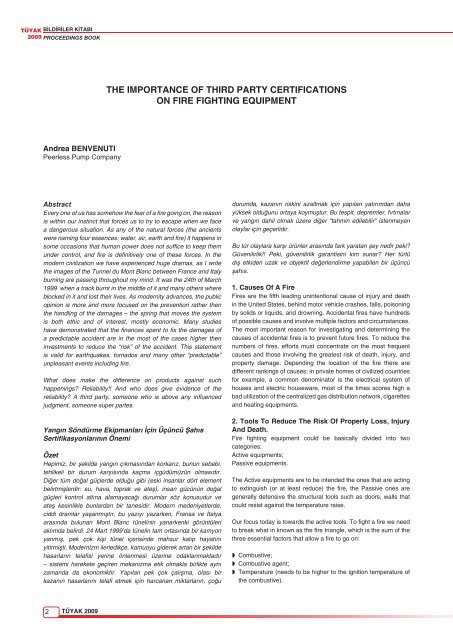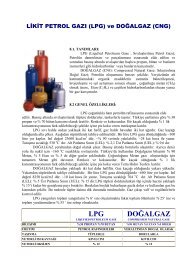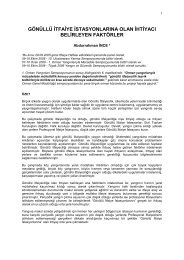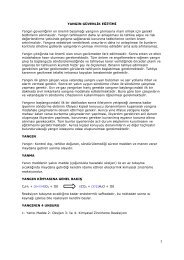buradan - Yangın
buradan - Yangın
buradan - Yangın
Create successful ePaper yourself
Turn your PDF publications into a flip-book with our unique Google optimized e-Paper software.
TÜYAK BİLDİRİLER KİTABI<br />
2009 PROCEEDINGS BOOK<br />
Andrea BENVENUTI<br />
Peerless Pump Company<br />
2<br />
TÜYAK 2009<br />
THE IMPORTANCE OF THIRD PARTY CERTIFICATIONS<br />
ON FIRE FIGHTING EQUIPMENT<br />
Abstract<br />
Every one of us has somehow the fear of a fire going on, the reason<br />
is within our instinct that forces us to try to escape when we face<br />
a dangerous situation. As any of the natural forces (the ancients<br />
were naming four essences: water, air, earth and fire) it happens in<br />
some occasions that human power does not suffice to keep them<br />
under control, and fire is definitively one of these forces. In the<br />
modern civilization we have experienced huge dramas, as I write<br />
the images of the Tunnel du Mont Blanc between France and Italy<br />
burning are passing throughout my mind. It was the 24th of March<br />
1999 when a track burnt in the middle of it and many others where<br />
blocked in it and lost their lives. As modernity advances, the public<br />
opinion is more and more focused on the prevention rather then<br />
the handling of the damages – the spring that moves the system<br />
is both ethic and of interest, mostly economic. Many studies<br />
have demonstrated that the finances spent to fix the damages of<br />
a predictable accident are in the most of the cases higher then<br />
investments to reduce the “risk” of the accident. This statement<br />
is valid for earthquakes, tornados and many other “predictable”<br />
unpleasant events including fire.<br />
What does make the difference on products against such<br />
happenings? Reliability!! And who does give evidence of the<br />
reliability? A third party, someone who is above any influenced<br />
judgment, someone super partes.<br />
<strong>Yangın</strong> Söndürme Ekipmanları İçin Üçüncü Şahıs<br />
Sertifikasyonlarının Önemi<br />
Özet<br />
Hepimiz, bir şekilde yangın çıkmasından korkarız, bunun sebebi,<br />
tehlikeli bir durum karşısında kaçma içgüdümüzün olmasıdır.<br />
Diğer tüm doğal güçlerde olduğu gibi (eski insanlar dört element<br />
belirtmişlerdir: su, hava, toprak ve ateş), insan gücünün doğal<br />
güçleri kontrol altına alamayacağı durumlar söz konusudur ve<br />
ateş kesinlikle bunlardan bir tanesidir. Modern medeniyetlerde,<br />
ciddi dramlar yaşanmıştır, bu yazıyı yazarken, Fransa ve İtalya<br />
arasında bulunan Mont Blanc tünelinin yanarkenki görüntüleri<br />
aklımda belirdi. 24 Mart 1999’da tünelin tam ortasında bir kamyon<br />
yanmış, pek çok kişi tünel içerisinde mahsur kalıp hayatını<br />
yitirmişti. Modernizm ilerledikçe, kamuoyu giderek artan bir şekilde<br />
hasarların telafisi yerine önlenmesi üzerine odaklanmaktadır<br />
– sistemi harekete geçiren mekanizma etik olmakla birlikte aynı<br />
zamanda da ekonomiktir. Yapılan pek çok çalışma, olası bir<br />
kazanın hasarlarını telafi etmek için harcanan miktarların, çoğu<br />
durumda, kazanın riskini azaltmak için yapılan yatırımdan daha<br />
yüksek olduğunu ortaya koymuştur. Bu tespit, depremler, fırtınalar<br />
ve yangın dahil olmak üzere diğer “tahmin edilebilir” istenmeyen<br />
olaylar için geçerlidir.<br />
Bu tür olaylara karşı ürünler arasında fark yaratan şey nedir peki?<br />
Güvenilirlik!! Peki, güvenilirlik garantisini kim sunar? Her türlü<br />
dış etkiden uzak ve objektif değerlendirme yapabilen bir üçüncü<br />
şahıs.<br />
1. Causes Of A Fire<br />
Fires are the fifth leading unintentional cause of injury and death<br />
in the United States, behind motor vehicle crashes, falls, poisoning<br />
by solids or liquids, and drowning. Accidental fires have hundreds<br />
of possible causes and involve multiple factors and circumstances.<br />
The most important reason for investigating and determining the<br />
causes of accidental fires is to prevent future fires. To reduce the<br />
numbers of fires, efforts must concentrate on the most frequent<br />
causes and those involving the greatest risk of death, injury, and<br />
property damage. Depending the location of the fire there are<br />
different rankings of causes; in private homes of civilized countries<br />
for example, a common denominator is the electrical system of<br />
houses and electric houseware, most of the times scores high a<br />
bad utilization of the centralized gas distribution network, cigarettes<br />
and heating equipments.<br />
2. Tools To Reduce The Risk Of Property Loss, Injury<br />
And Death.<br />
Fire fighting equipment could be basically divided into two<br />
categories:<br />
Active equipments;<br />
Passive equipments.<br />
The Active equipments are to be intended the ones that are acting<br />
to extinguish (or at least reduce) the fire, the Passive ones are<br />
generally defensive the structural tools such as doors, walls that<br />
could resist against the temperature raise.<br />
Our focus today is towards the active tools. To fight a fire we need<br />
to break what in known as the fire triangle, which is the sum of the<br />
three essential factors that allow a fire to go on:<br />
w Combustive;<br />
w Combustive agent;<br />
w Temperature (needs to be higher to the ignition temperature of<br />
the combustive).





